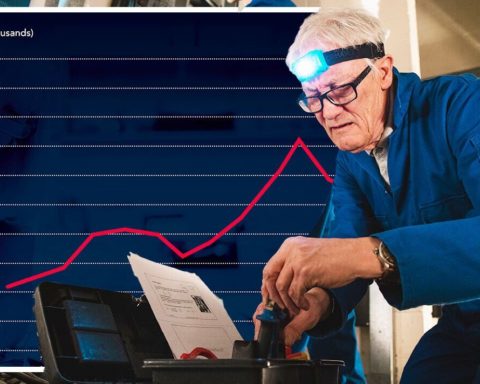The Russian invasion of Ukraine has caused massive volatility on financial markets.
Many investors will be looking at a hole in their portfolios, after already watching popular US tech stocks plummet over the past few months.
The usual advice is to hold your nerve, but some careful rejigging to account for increased risk would seem sensible – even if you’re disinclined to follow one veteran investor’s advice and move half your investments into cash.

Moscow launched an invasion of its neighbour Ukraine, sparking furious condemnation around the world
So where else can you look to shore up your portfolio?
Gold is already nearing £2,000 an ounce, and the price might even beat its previous record of $22,075 set in 2020.
But investments in Japan – normally a safe haven – are struggling and it is not tipped by any of the experts below as a place to move your cash right now.
We round up their views on the current crisis, including on how severe and longlasting it could be, and what investing strategies might work best in the current climate.
How long might the crisis take to play out?
This is ‘red alert’ time and market falls of 50 per cent and more can be expected, says managing director of research platform FundExpert Brian Dennehy.
He is recommends that investors move to 50 per cent cash, and lays out a 10-point action plan here.
The senior economist team at financial research firm Capital Economics said of the invasion’s market impact: ‘Unless the situation in Ukraine improves, the global de-risking now underway will probably continue.
‘There are few obvious parallels to this crisis, but major stock indices dropped 20-25 per cent after Iraq invaded Kuwait in 1990, although they rebounded once US intervention brought the war to a swift end.
‘That suggests another 10-20 per cent fall from current levels is quite plausible.
‘Aside from how the Russia-Ukraine war evolves, the key factor that will determine how bad the market fallout becomes is how major central banks respond.
‘Before the Russia-Ukraine conflict escalated over the past couple of weeks, equities were already under pressure from the surge in risk free rates at the start of 2022 as the Fed and other central banks signaled a more aggressive pace of monetary policy tightening.
‘If the conflict prompts policymakers to hold off, or at least slow down, the tightening process, that may cushion the blow to risky assets.’
Investing experts say ‘don’t panic’
The conventional investing wisdom is to ride out market storms, particularly if you are investing for the long term.
‘Historically, the greatest risk for investors from geopolitical crises has come from overreacting and under-diversifying,’ says Mark Haefele, chief investment officer of global wealth management at UBS.
He notes that the current volatility shows markets had not fully priced in the likelihood of deeper conflict.
And he believes energy prices could head higher, and oil-reliant economies may see economic activity take a hit in non-energy sectors.
But he adds: ‘While it is impossible to judge the precise magnitude of geopolitical effects on markets, such events have generally not prevented equities from moving higher over a medium-term horizon, and drawdowns driven by geopolitical stress events are typically short-lived for well-diversified portfolios.
‘We think it is important for investors to maintain a calm stance and keep a broad perspective, and to build a portfolio robust enough to navigate the Ukraine crisis and rising US interest rates.’

Jason Hollands: ‘It’s at times like this when taking the long view is essential’
Jason Hollands, managing director of investing platform Bestinvest, says: ‘Knee-jerk reactions to short-term stock market fluctuations rarely go well for the individual investor.
‘This is a rapidly developing situation. It’s at times like this when taking the long view is essential.
‘What we do know, because it had already begun before Russian tanks moved into Ukraine, is that we are moving into a very different environment from the one investors have been used to in recent years: namely inflation is much higher than anything seen for decades and interest rates are on the rise and only the in the early foothills of their upward climb.
‘War in Ukraine simply adds to momentum to this trend because further rises in energy prices add to inflationary pressures, so investors need to take note.’
Hollands warns there is now a real possibility that the Bank of England’s forecast of CPI inflation peaking at 7.25 per cent in April will be exceeded, and that development will be totally unprecedented for many of today’s investors.
He takes a different view from Capital Economics on the potential response of central banks, saying they will be under pressure to raise interest rates more aggressively.
‘High inflation and rising borrowing costs have implications for household finances and consumer spending, but also for business costs and for investment markets, not least because in recent years global investors have been used to central banks riding to the rescue in times of crisis with super-loose monetary policy.
‘With their hands tied by rising inflation, it looks like equity markets could be left to fend for themselves this time.’
Maike Currie, investment director at Fidelity International, offers three reasons to think that calmness and staying the course are likely to be better investment strategies in the days and weeks ahead.
‘First, those selling out now are likely to be already sitting on losses in the year so far, so selling now means locking in those losses,’ she says.
Share prices could recover from their current levels this year, but investors need to be invested to take advantage of that, if and when it arrives, explains Currie.
‘Second, the falls we have seen in response to Russia’s action have been broad-based, with few sectors escaping as investors flee from all assets they see as risky.
‘That means there will be many companies that suffer short-term losses despite not particularly being impacted by the trouble. Don’t be surprised to see some snap back in prices in the coming days following today’s initial reaction.
‘Third, anyone contributing regularly to investments need to continue to make those investments if they want their long-term investing plans to pay off.
‘Investing regular amounts at regular intervals means that, when prices do fall, your money buys more assets. You are buying when prices are low – a fundamental building block of successfully investing.’
Where are the safe havens right now?
Jason Hollands of Bestinvest runs through some of the potential options.
Gold: The price was nearing $2,000 yesterday but fell back to around $1,910 today. As the crisis continues, there is a possibility it could top its record of $2,075 hit in summer 2020.
Hollands says: ‘Although the price of gold has spiked recently, as it nearly always does in times of crisis, it is worth bearing in mind that it does not offer investors a yield.
‘Historically there tends to be an inverse correlation between gold prices and the yield on US Treasury Inflation Protected Securities.
> How to invest in gold: A guide to buying into the world’s oldest safe haven through bullion, coins, funds and ETFs
US TIPS: ‘Yields have risen since the start of the year and, given the potential inflationary impetus rising energy prices will have, they should also be considered as a safe haven asset over the coming months,’ says Hollands.
Hollands suggests the currency-hedged Lyxor Core US TIPS UCITS ETF for a pure play on US Treasury Inflation Protected Securities, or Personal Assets Trust if you want to add some extra resilience to your portfolios with a multi-asset fund.
The latter has a capital preservation mandate and is 29 per cent invested in US Tips, 38 per cent in stocks, 11 per cent in gold and 20 per cent in UK bonds and cash.

The UK: ‘Investors heavily exposed to growth sectors like tech and the US market are in a risky place to be at the moment, with valuations still high and extremely vulnerable to the inflationary environment, with borrowing costs on the rise,’ says Hollands.
‘Investors topping up their Isas might now conside rebalancing in favour of the UK in particular, as it has hefty exposure to financials, materials and energy which respective represent 18.1 per cent, 8.5 per cent and 10.2 per cent of the UK stock market.
‘Oil and energy stocks will benefit from the global surge in crude and gas prices, while banks will be beneficiaries of rising global interest rates.
‘This will require quite an about turn for many investors who have shunned the UK market in recent years either due to Brexit worries or because it lacked exposure to technology stocks. We are moving into a different world now.’
Bestinvest’s top picks for UK equity funds include Artemis UK Select, Fidelity Special Situations and Jupiter UK Special Situations.
Dividends: Investors should take note of the value of dividends again, according to Hollands.
‘During the growth stock boom of recent years, many investors haven’t given them a second thought. However, in times of uncertainty and when share prices are zig-zagging around, the receipt of a well cover dividend provides a welcome degree of predictability that can either be banked or reinvested.
‘In this respect, the UK remains the premier developed market globally for dividend pay-outs. But don’t forget to try and hold income generating shares and funds within your Isa allowances, as the Chancellor is raising dividend tax rates in the new financial year.’
Hollands sugggests Threadneedle UK Equity Income and TM RWC UK Equity Income.
What other strategies could you consider?
Mark Haefele of UBS suggests five ways to keep your portfolio on track amid the uncertainty.
Keep a diversified portfolio: ‘By diversifying across regions, sectors, and asset classes, investors can reduce their exposure to idiosyncratic risks related to the crisis in Ukraine, or to other emergent political risks around the world,’ he says.
‘The combined revenue exposure of the S&P 500 to Russia and Ukraine, for example, is only about 1 per cent.
‘Diversification offers intrinsic bear market protection. In bear markets since 1945, the S&P 500 fell an average 34.5 per cent and spent 39 months (about three-and-a-half years) “underwater”.
‘A 60/40 portfolio [60 per cent stocks and 40 per cent bonds] lost an average of 20 per cent and registered a fresh record high, on average, within 30 months (about two-and-a-half years).’
Use commodities as a geopolitical hedge: ‘Russia accounts for around 40 per cent of the European Union’s gas imports and 30 per cent of its oil imports, and is the world’s largest wheat supplier.
‘Ukraine is a material exporter of corn, wheat, and oilseeds.
‘Amid the risk of supply disruptions, we think broad commodities can be an effective geopolitical hedge for portfolios, as well as offering an attractive source of returns in an environment of accelerating growth, persistent inflation, and higher rates.’
Position for US dollar strength: ‘The US dollar is a safe-haven currency that tends to rally during periods of heightened geopolitical uncertainty or risk-off sentiment in financial markets,’ says Haefele.
‘In addition, we think that market expectations of six or seven US interest rate hikes are likely to support the US dollar in the months ahead.’
Buy the winners from global growth: ‘Against a backdrop of heightened concerns about Ukraine, inflation, and interest rates, it is important to remember that global economic growth remains above trend and Covid-19-related restrictions are being lifted.
‘We think this should continue to favor value and cyclical sectors and markets, including energy, financials, and the eurozone.
‘It is worth noting that, despite their proximity to the crisis in Ukraine, the continued outperformance of Eurozone equities compared to US equities over the past month shows that the forces of economic recovery remain powerful and are potentially still a more important driver of global markets than events in Eastern Europe.’
Build up some defensive investments: ‘With uncertainty set to remain elevated, investors looking to reduce volatility in portfolios can consider balancing some of their cyclical exposures with defensive sectors and strategies.’
Haefele suggests global healthcare as defensive sector, and pursuing dividends.
Some links in this article may be affiliate links. If you click on them we may earn a small commission. That helps us fund This Is Money, and keep it free to use. We do not write articles to promote products. We do not allow any commercial relationship to affect our editorial independence.





